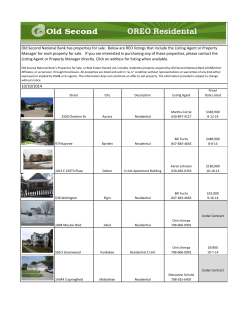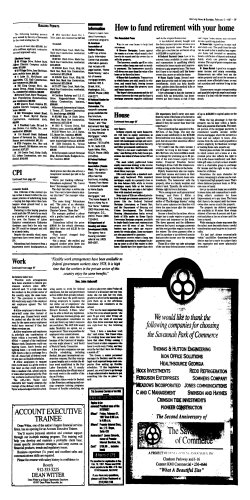
Urban Design Webpage-Definitions What is Urban Design?
Urban Design Webpage-Definitions What is Urban Design? Urban Design addresses the character and quality of the built environment in relation to the human scale. Urban designers are involved with building design (specifically massing, scale, and articulation), streetscape, and open space design. Human Scale-Human scale can be defined as the proportional relationship of the physical environment (buildings, trees, parking lots, streets, etc.) to human dimensions. Massing Massing describes the relationship of the building’s various parts to each other. Architectural elements such as windows, doors and roofs as well as interior floor plans can affect building mass. Massing is important because it is one of several details that determine the visual interest of a building and how it blends with its surroundings. Can you identify the massing differences in these structures? Scale Scale is the relationship of a building in terms of size, height, bulk, intensity and aesthetics to its surroundings. A building’s scale is contextual in nature and is a key factor in determining how well it blends with the neighborhood. The scale of new development should compliment the neighborhood. Articulation Articulation refers to the division of a building into meaningful parts. Elements of articulation include treatment to porches, balconies, doors, windows, roofs, materials and other architectural details. This residence is articulated on all sides with windows, wrap around porch, variances in façade depth and color and material changes. Streetscape A streetscape refers to the natural and man-made elements in or near the street right of way, including buildings, building setbacks, lawns, sidewalks, street furniture, street trees, signs, street lights, transportation amenities, and public art. This retail oriented street has plenty of pedestrian amenities. Landscaping, decorative lighting, on-street parking, buildings located along sidewalks and clear glass windows help create comfortable walking environment and pleasant shopping experience. This cross-section drawing shows typical streetscape elements-planting strips with trees separating the pedestrian from the curb, bike and travel lanes and a median for landscaping and pedestrian refuge. Infill Development A type of development occurring in established areas of the city. Infill can occur on long-time vacant lots or on pieces of land with dilapidated buildings, or can involve changing the land use of a property from a less to a more intensive one. In NoDa (North Davidson Arts District) the corner building was saved and renovated. A new mixed-use building was constructed next to it. Setback The setback is the distance between the building face and curbline or right of way line. This setback in this new residential development includes the front yard, sidewalk and planting strip. The setback of the houses is consistent along the entire block which creates a consistent streetscape. The large maturing tree in the foreground was saved and integrated into the front yard. Parking should not be located within the setback. The pedestrian should be able to enter the building directly from public sidewalks. Open Space In large developments a certain amount of the site is required to have open space. To help create active, pedestrian friendly communities open spaces should be safe, useable and easily accessible. Amenities such as seating, art, landscaping and fountains enliven common open areas. Common open spaces should be designed with the potential for high visibility. In this development the residential units and entrances to the building face the open spaces. Recent Plans with Urban Design Guidelines Small Area plans-Dilworth, Rocky River, Newell, Washington Heights, Optimist Park Center City-First Ward, Second Ward, Third Ward, Fourth Ward, Government District, Tryon Street Mall, Gateway (including multi-modal), Streetcar, Bobcats Arena Streetscape Projects Central Ave., Plaza Rd., Elizabeth Ave., Pence Rd., West Morehead St., Freedom Drive, Rozzelles Ferry Rd., Andrill Terrace, Statesville Avenue, Tuckaseegee Rd., Wilkinson Blvd., Morris Field., Intersection Design-Beatties Ford Rd./West Trade St., Tryon St/Dalton Ave., Tryon St./East 36th St., West Blvd/Remount Rd. Signage-Wilmore, Washington Hts Rezoning-Colony/Rea, WalMart at Wilkinson, Lowe’s, East Park (Grubb), Southpark, Galleria, Morningside Special Projects-Habitat for Humanity, Façade Improvement Program, Connectivity Projects, West Blvd. shopping center, Piedmont Courts, NoDa, SouthEnd, Biddleville, Design Standards, Piedmont Court Glossary Images Rezoning-Through the rezoning process Planning’s urban design staff provide recommendations for improving the built environment. Selwyn Corners shopping center Mixed-Use rezoning in NoDa 3030 South-A residential development in South End Intersection Design-Intersections are often gateways into communities. Designers have applied a variety of improvements to enhance intersections for neighborhoods while improving pedestrian safety. Intersection improvements at North Davidson and East 36th Street included pedestrian scale lighting, brick paved sidewalks and decorative columns. An extensive intersection design and gateway project at West Trade Street, West 5th Street, Beatties Ford Rd. and Rozzelles Ferry Rd. also known as Five Points in Biddleville. The project included relocating the landmark Stone Entry Gate, and enhancing the pedestrian envirnonment with brick paved sidewalks, decorative lighting, landscaping and open space. Utility lines were buried to reduce visual clutter at the intersection. Public Art-Art can be used to create visual interest and provide educational benefits in the public realm. It should be applied in many different forms and places. A collection of artwork at Central Avenue and Thomas Avenue. A decorative planter, benches and birdhouses at Biddleville/Five Points. Reuse-An effective way to preserve vacant buildings is to reuse them. Vacant buildings have been used for offices, housing, libraries, schools, retail business, art studios, museums, churches and other beneficial uses. The old Coca-Cola building downtown is now used for office space. Many older buildings have design details such as masonry walls, high ceilings, exposed beams, wood floors and large, operable windows. Mixed use-This often used term describes a development pattern that is combines multiple uses in one structure vertically. Vertical mixing of uses saves valuable real estate for leasable space rather than parking lots. This CVS pharmacy has office uses on the second floor. Gateway Village in uptown Charlotte is one of the most well-known and successful new mixed-use developments in the United States. Two examples of grocery stores with office and/or residential uses on top. Parking is located below ground and in a centralized parking structre hidden from public view. Live/Work-This development type requires the owner of a business to reside in a unit within the same building. Small retail shops and boutiques along North Davidson St. are owned and maintained by the owners in the upstairs residential units. Residential Design-Urban designers are parttiularly interested in the development of residential structures that enhance the livability of communities. Design guidelines for residential development can be found in Small Area Plans, the General Development Policies (GDP) and other Planning documents. Planning staff worked with community leaders, Neighborhood Development and Habitat for Humanity to produce new designs for homes in Washington Heights based on area plan guidelines. A typical design recommendation is to provide articulation on building facades that are in public view. The corner house pictured here has windows, varying roof types and variation in the wall plane. Connectivity-Part of building livable communities is providing adequate accessibility for all modes of travel. Designers seek opportunities for pedestrian, bike and vehicular connections within new development and within the surrounding community. Examples of pedestrian and bike trails in residential communities. Recently completed connections in existing neighborhoods that improve access to parks, greenways and schools. Retail Development Streetscape Projects Central Avenue Parkwood Avenue Tuckaseegee Rd. Rozzelles Ferry Rd. Eastland area Influential Developments Charlotte is home to several landmark residential and mixed-use communities, some of which date back to 19th century. Famous urban designers such as Frederick Law Olmstead and John Nolen left their mark on the city. Developments such as e are recent develops that are worthy of highlighting as well. We expect this list to grow over time! Myers Park-1911 Dilworth-1891 Washginton Heights-1912 Biddleville-1867 Fourth WardFirst WardPark at Oaklawn/Arbor Glen Olmstead Park Birkdale Village Mill Villages (SouthEnd, North Charlotte) Gateway Village Midtown Square Mall redevelopment Morningside Apartments provide a good example of the "garden apartment" or “superblock” multi-family rental housing property type, which has roots in the English Garden City Movement and German Superblock concepts respectively. These two movements developed in Europe in response to the need for massive housing after World War I and to the forces of urbanization and industrialization at the turn of the twentieth century. The core idea was that multi-family housing units should be placed in a garden-like, open setting featuring common courtyards that would stimulate interaction between the residents and emphasize a sense of community for the new urban society. First Ward Birkdale Village
© Copyright 2025





















